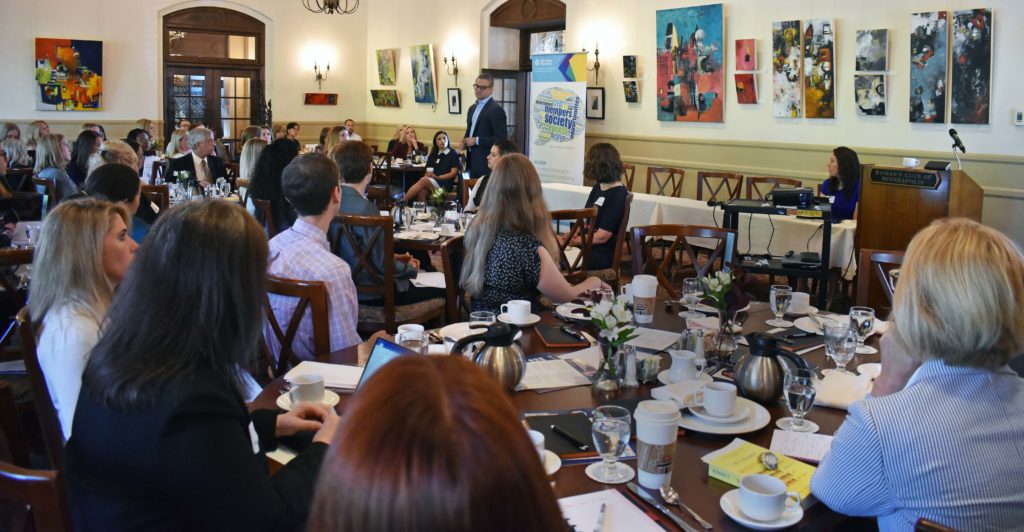By: Hilary Wiek, CFA, CAIA, Society Volunteer

In the first two segments of my reporting on the Diversity and Inclusion event of June 5, I discussed the misconceptions about the event and some of the high-level topics discussed by our esteemed speakers. In this final installment, I will outline research and resources on the topic that may 1) help convince some people that there is supportive evidence to justify diversify and inclusion efforts in the workplace and 2) provide guidance on solving some of the problems outlined previously. As a recap of the prior blog post, one broad topic area was having productive conversations about diversity and inclusion, a second was hiring a diverse workforce, and a third was retaining a diverse workforce.
Speakers at the CFA Minnesota event stated that bringing evidence-based findings to discussions about diversity and inclusion has really helped to advance the topic, in some cases converting individuals who were skeptical there even is a problem. A number of studies have found what many who have given this topic any thought would have suspected from anecdotal evidence, but having research to back up the suspicions has been powerful.
For data and evidence, the University of Chicago, in partnership with private sector support, has dedicated resources to study this topic under the moniker The Science of Diversity and Inclusion (SODI). Their website states that the initiative “brings together leading researchers and organizations to identify, accelerate, and apply new evidence-based approaches to advance diversity, inclusivity, and belonging in our places of work and learning.” Profiles of the affiliated researchers, their areas of study, and a summary of their findings can be found here.
One of the more interesting studies mentioned at the CFA event was from a team out of Columbia University (Sheen S. Levine, Evan P. Apfelbaum, Mark Bernard, Valerie L. Bartelt, Edward J. Zajac, and David Stark) about homogenous and heterogenous investment teams (called “experimental markets” in the study). A link to the work, entitled Ethnic Diversity Deflates Price Bubbles,” can be found here. From the abstract (the italics are mine at the end):
“Markets are central to modern society, so their failures can be devastating. Here, we examine a prominent failure: price bubbles. Bubbles emerge when traders err collectively in pricing, causing misfit between market prices and the true values of assets. The causes of such collective errors remain elusive. We propose that bubbles are affected by ethnic homogeneity in the market and can be thwarted by diversity. In homogenous markets, traders place undue confidence in the decisions of others. Less likely to scrutinize others’ decisions, traders are more likely to accept prices that deviate from true values. To test this, we constructed experimental markets in Southeast Asia and North America, where participants traded stocks to earn money. We randomly assigned participants to ethnically homogeneous or diverse markets. We find a marked difference: Across markets and locations, market prices fit true values 58% better in diverse markets. The effect is similar across sites, despite sizeable differences in culture and ethnic composition. Specifically, in homogenous markets, overpricing is higher as traders are more likely to accept speculative prices. Their pricing errors are more correlated than in diverse markets. In addition, when bubbles burst, homogenous markets crash more severely. The findings suggest that price bubbles arise not only from individual errors or financial conditions, but also from the social context of decision making. The evidence may inform public discussion on ethnic diversity: it may be beneficial not only for providing variety in perspectives and skills, but also because diversity facilitates friction that enhances deliberation and upends conformity.”
The CFA Institute has been spending time on diversity and inclusion as well, conducting surveys and hosting workshops with industry participants to better assess the state of diversity and inclusion in the industry, provide public data from these efforts, and come up with ideas on how to address the problems. Here is a link to the CFA Institute’s published work derived from its efforts, “Driving Change: Diversity & Inclusion in Investment Management,” which was distributed at the CFAMN event.
Once evidence has been supplied and hopefully accepted, the next question is what can be done about it? One of the resources mentioned several times at the CFA event was the book What Works, by Iris Bohnet, who is affiliated with the SODI efforts outlined above. The SODI site summarizes the book as a resource “to hand decision-makers the tools they need to move the needle in classrooms and boardrooms, in hiring and promotion, benefiting businesses, governments, and the lives of millions.” A short video summarizes Bohnet’s work here. She also authored the following articles:
- How to take the Bias Out of Interviews, Harvard Business Review
- Designing a Bias-Free Organization, Harvard Business Review
The pipeline of diverse candidates was another of the significant issues identified at the CFAMN event – even if a firm wants to hire from a diverse talent pool, there is often a dearth of qualified candidates fitting diverse profiles. Several organizations were mentioned at the event that are attempting to reach women and minorities earlier in their education to let them know a) that the investment field could be an attractive career option and b) what they need to do in order to prepare oneself for a career in the field (including education and internships).
One organization called out at the event was Girls Who Invest (GWI), which got its start in 2015. Each summer since 2016, GWI has held a four-week summer educational program for college women, after which each participant works in a six-week paid internship. The stated goal of the organization is to get 30% of the world’s investable capital managed by women by 2030. A New York Times article linked on the website states that only 7% of investment managers in the $15 trillion mutual fund industry are women. If you are looking for a way to help solve the diversity problem in our industry, GWI seeks volunteers to mentor students, speak at events, and teach courses during its college summer intensive learning program. They also seek financial partners in the investment management industry to provide mentors and host interns.
Another organization is Invest In Girls. Per the website: “Invest In Girls works with schools, community organizations, corporations and foundations to provide financial literacy programming to young girls.” This group’s programs seek to educate 10th, 11th, and 12th grade girls in workshops before they get to college, allowing them to learn about personal finance and careers in finance while there is still time to formulate a higher education plan. This organization is seeking volunteers to make short videos for its Role Model Exchange outlined here.
In 2013, financial services firms in Chicago came together with The Chicago Community Trust to form the Financial Services Pipeline Initiative. The key goals of this group are to 1) increase the representation of Latinos and African-Americans, at all levels, within the Chicago area financial services industry and 2) improve the overall cultural competency within the Chicago area financial services industry. While volunteer activities may be out of reach for the CFAMN membership, the website has interesting data and may provide ideas for how to bring some of this group’s activities back to our region.
Other resources/research not discussed at the event, but suggested by the speakers:
- Scott Page
- Ashley Goodall
- Nine Lies About Work (book abstract here)
In closing, did you know this event was planned and organized by a CFAMN volunteer? Thanks again to Amy Jensen, CFA, Investment Director at Northwest Area Foundation who put together this enriching program. Do you have a great idea to share or a project you feel passionate about? E-mail society staff and they’ll help you make it happen!






